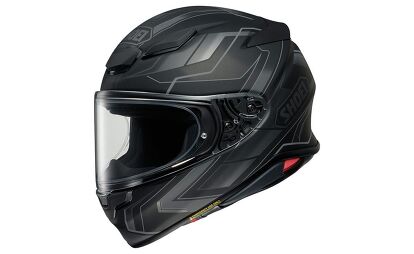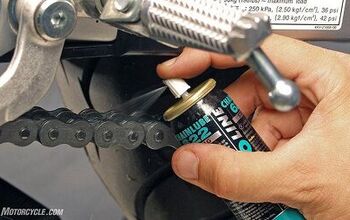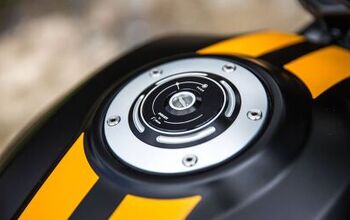Shoei Helmets: Everything You Need To Know

Producing motorcycle helmets since 1960
Most motorcycle riders know of Shoei Safety Helmet Corp. as being a manufacturer of premium motorcycle helmets and one of the most popular helmet brands in the world. What many riders don’t know is that Shoei began producing helmets in 1960. Prior to that, the company’s helmets were primarily directed towards the construction industry. In 1962, the company provided helmets for the motorcycle racing market, and racing remains a key component of Shoei’s helmet development to this day. You don’t think that talents like Marc Marquez would use just any helmet – no matter the sponsorship payment – do you?
In 1962, Shoei developed its first racing helmet, the SR-1. Just six years later the company had grown to the point that it opened the Shoei Safety Helmet Corporation in California. The S-12 obtained Shoei’s first Snell approval. Other milestones include: the STZ (S-20) adopted Shoei’s original two-piece structure in 1972, released the GR-Z (the worlds first full-face helmet to use carbon fiber) in 1976, released the full-face EX-2 motocross helmet in 1982, and introduced injection-molded shield designs in 1983. From there, the procession of helmets related to current models rolled out: VF-X motocross helmet (1991), RF-200 (1989), X-Eleven (2002), Multitec modular (2007), Neotec (2012), J-Cruise (2012), GT-Air (2013), and Hornet ADV (2015).
Despite the high-tech nature of motorcycle helmets, the manufacturing process is an exacting process combining state-of-the-art manufacturing and human craftsmanship. By the time a Shoei helmet is ready to be packaged and shipped, more than 50 people have laid hands on the helmet. As they have been since the company’s inception, all Shoei helmets are manufactured in Japan.
Table of Contents
-
1. Shoei RF-1400: Shop Now
-
2. Shoei X-Fourteen: Shop Now
-
3. Shoei RF-1200: Shop Now
-
4. Shoei RF-SR: Shop Now
-
5. Shoei GT-Air II: Shop Now
-
6. Shoei Neotec II: Shop Now
-
7. Shoei J-Cruise II: Shop Now
-
8. Shoei J•O: Shop Now
-
9. Shoei RJ Platinum-R: Shop Now
-
10. Shoei Hornet X2: Shop Now
-
11. Shoei VFX-EVO: Shop Now
Shoei RF-1400
Shoei’s most recently updated helmet, the RF-1400, was released in 2021 and is the replacement to the extremely popular Shoei RF-1200 that was released in 2014. With the RF-1400, Shoei didn’t create a new helmet out of whole cloth. Instead, the RF-1400 is a refinement of its predecessor. Anyone who is familiar with the RF-1200 can immediately see the heritage in the RF-1400’s profile. Still, through extensive use of Shoei’s in-house wind tunnel, the RF-1400 manages a 6% reduction in lift and a 4% reduction in drag when compared to its elder sibling. This is the type of iterative refinement that earns Shoei its premium reputation.
MO Tested: Shoei RF-1400 Helmet Review
The biggest change to the RF-1400, from a user’s perspective, is the new visor, which locates the latch in the center with the redesigned chin vent. The new location allows for opening and closing forces to be evenly distributed between the spring-loaded base plates for more uniform opening/closing effort and a tighter seal. Since the eye port opening is a source of both wind, weather, and noise ingress into the helmet, the beading that seals the visor interface was redesigned and even features dual drains on the outer bottom edges.
The quietness of the RF-1400 bears mentioning. The RF-1400 has stepped in to take RF-1200’s place in side-by-side tests. One key area for noise to penetrate the sanctity of the helmet interior is the large hole required to insert the rider’s head. The redesigned cheek pads assist with the snug-but-comfortable fit.
Behind the scenes, Shoei’s helmet shells incorporate a proprietary multi-ply matrix specifically designed to meet both SNELL M2020 and DOT standards. These layers of fiberglass with lightweight organic and high-performance fibers are hand laid by highly-trained technicians to assure consistent shell thickness guarantees proper strength and weight. This process produces strong, light, elastic shells for absorption of impacts that the rider might encounter.
The Shoei RF-1400 is available in sizes XS-XXL in six solid colors and 14 graphic designs, Starting at $530.
Shoei X-Fourteen
Racers want the ultimate in both safety and performance, and the flagship Shoei X-Fourteen has both. Developed with input from the world’s top racers, like the aforementioned Marquez, the X-Fourteen has all the features that racers – and performance-minded riders – demand.
MO Tested: Shoei X-Fourteen Review
The X-Fourteen’s swoopy shape was designed and tested in SHOEI’s wind tunnel to yield premium aerodynamics and stability. The shell’s shape, along with a patent-pending Rear Stabilizer, maximizes high-speed stability and eases any negative forces experienced by the rider. The rear flaps’ aerodynamics are adjustable to rider preference by replacing the standard flaps with narrower ones. Special ridges on the shell, chin bar, and visor reduce turbulence and drag.
Ventilation is provided by six intake and six exhaust ports, including side outlets to help draw hot air away from the rider. A cheek pad cooling system delivers cool air to the rider’s face, while tunnels between the layers of the EPS liner deliver necessary air flow. The multi-density EPS construction allows impact absorption to be fine tuned to the needs of the location on the helmet, allowing for a lighter, smaller size. All of this is encapsulated within a hand laid protective shell of layered fiberglass with lightweight organic and high-performance fibers.
To get the fit that racers require, a removable, washable, replaceable and adjustable inner liner is used. The pads themselves are three-dimensionally shaped to better fit the contours of the rider’s head. Varying thickness cheek pads are available to complete the fit.
The Shoei X-Fourteen is available in sizes XS-XXL in three solid colors and 11 graphic designs, starting at $770.
Shoei RF-1200
Riders looking for a premium helmet experience at a reduced price, can look to the Shoei RF-1200. Although it has been replaced by the RF-1400, Shoei still lists the RF-1200 in its model line. Released in 2014, the RF-1200 had a good run at the top of Shoei’s street-focused line and still offers great fit, comfort, and protection. With the associated price reduction thanks to the advent of the RF-1400, the RF-1200 delivers new value to riders.
MO Tested: Shoei RF-1200 Helmet Review
The Shoei RF-1200 is available in sizes XS-XXL in 10 solid colors and 19 graphic designs, starting at $486.
Shoei RF-SR
The Shoei RF-SR features the same level of safety as the higher price point helmets while offering a reduced feature set to keep costs down. The shell is compact and aerodynamic. Rider comfort is addressed via three user-controllable intake and two exhaust openings. The shield system offers quick swapping of visors. The removable, washable inner liner delivers comfort over the long haul.
The protective features are typical Shoei quality. The outer shell is the company’s proprietary combination of hand laid layers of fiberglass with organic fibers and resin formed into a six-ply matrix. The internal dual-layered EPS foam varies the density of the foam to match the protective requirements of that location on the helmet while maintaining a compact, lightweight design. The separate layers create pathways for cooling airflow.
The Shoei RF-SRis available in sizes XS-XXL in five solid colors, starting at $486.
Shoei GT-Air II
Designed with versatility in mind, the Shoei GT-Air II delivers comfort and function in a variety of riding situations. Although Shoei lists the GT-Air II as a touring helmet, it offers a feature set that should appeal to daily riders as well as long-distance riders.
MO Tested: Shoei GT-Air II + Sena SRL2 Review
The GT-Air II allows the rider to have visual comfort in varying light conditions, thanks to the internal tinted visor. If you ride from dawn to after dusk, you won’t have to carry an extra shield with you. The shield also features easy replacement and a first position notch in its travel to allow ventilation to prevent fogging.
Ventilation is important for long days in the saddle, and the GT-Air II provides three intake ports and five exhaust vents to flow the maximum air possible. As with the other Shoei helmets, the GT-Air II was extensively tested in the company’s wind tunnel to create a slippery, quiet shell, which uses Shoei’s multi-ply matrix AIM shell.
As if that isn’t enough, Shoei made arrangements with Sena to create a bespoke Bluetooth communication system, the Sena SRL2, for the GT-Air II. Riders who purchase this accessory have all of the benefits of connection to their smartphones and touring bike’s entertainment systems, not to mention the ability to chat with nearby riders.
The Shoei GT-Air II is available in sizes XS-XXL in seven solid colors and 14 graphic options, starting at $600.
Shoei Neotec II
With age comes (hopefully) wisdom, and over time, every MO staffer has learned the convenience of modular helmets, and we use them for most of our day-to-day riding because we dig being able to flip the chin bar out of the way when pumping gas or going into a convenience store. Naturally, Shoei manufactures one of our staff-favorite modulars, the Neotec II. Now riders, from commuters to cruisers to tourers, can enjoy this extremely flexible helmet.
MO Tested: Shoei Neotec II Helmet + Sena SRL Communicator Review
We’re sold on full-face helmets from a safety perspective, and the Shoei Neotec II provides that. However, at a stop, they can become confining. Then, with the push of the easy-to-operate central release button, the chin bar can be flipped out of the way for communication or comfort. When it’s time to get back under way, the chin bar closes with a sturdy click, notifying the rider that it is locked in place.
The Neotec II has other convenience features, like the built-in tinted visor that flips into position via a slider on the left side of the helmet. Donning and doffing the helmet is made much easier thanks to the Micro Ratchet Chinstrap instead of the typical double D-ring. The ventilation benefits from a three-position upper air intake and a centrally-located rear exhaust. Finally, a proprietary Sena SRL Bluetooth communication system can be installed into the bespoke mounting positions within the helmet in just a few minutes, vastly increasing the utility of this helmet for road warriors.
As with the above Shoei helmets, protection is provided by the Multi-Ply Matrix AIM shell and Multi-Piece EPS liner.
The Shoei Neotec II is available in sizes XS-XXL in eight solid colors and nine graphic options, starting at $700.
Shoei J-Cruise II
Riders who prefer open-face helmets can also benefit from Shoei’s quality construction. The J-Cruise II is compact, lightweight, and aerodynamic, and it also features the benefit of an internal sun visor. The protection comes from the same Multi-Ply Matrix AIM shell and Multi-Piece EPS liner as other Shoei helmets, just without the chin bar. An optional Sena SRL2 Bluetooth communication system is available.
The Shoei J-Cruise II is available in sizes XS-XXL in five solid colors, starting at $550.
Shoei J•O
What is there to say about this helmet? The Shoei J•O is a thoroughly modern take on a retro open-face helmet. The shell is constructed from a proprietary matrix of lightweight organic and high-performance fibers mated to a liner made of multi-density EPS foam. The retractable clear shield features three locking positions plus fully hidden. Changing the shield requires no tools.
The Shoei J•O is available in sizes XS-XXL in five solid colors and two graphics, starting at $380.
Shoei RJ Platinum-R
With the RJ Platinum-R, Shoei delivers the quintessential open-face helmet. Constructed with the company’s Multi-Ply Matrix AIM shell and Multi-Piece EPS liner, the RJ Platinum-R offers two forehead vents and a sunshade that keeps your eyes in the shade without helmet lift at speed, like some other visors. You provide your own eye protection.
The Shoei RJ Platinum-R is available in sizes XS-XXXL in seven solid colors, starting at $380.
Shoei Hornet X2
Shoei calls the Hornet X2 an all-road helmet, we’d call it an adventure touring helmet that is as comfortable racking up the miles on the highway as it is with goggles mounted on your favorite forest road or even off-road riding area. By this point in the article, you should be familiar with Shoei’s Multi-Ply Matrix AIM shell, Multi-Piece EPS, and removable, washable liner. So, we’ll focus on what makes this helmet different.
MO Tested: Shoei Hornet X2 Review – Revisited
Visually, the first two things you notice about the Hornet X2 are the large eye port and the bill (or visor). The faceshield has all the features you’d expect from a Shoei: quiet, air-tight fit and a plateless design. Swapping faceshields does require partially disconnecting the visor, but that is the nature of the helmet. The eye port is large enough to accommodate some goggles (but not all), making the Hornet X2 a viable off-road option when the situation allows. The visor itself keeps the sun out of your eyes, but its clever design prevents it from providing lift to the helmet up to supra-legal speeds.
The off-road style chin bar leaves plenty of breathing room, and the venting is very effective, even at low speeds on the trails in hot weather.
The Shoei Hornet X2 is available in sizes XS-XXL in five solid colors and three graphics, starting at $600.
Shoei VFX-EVO
The VFX-EVO is Shoei’s entry in the super-competitive off-road helmet market, and as a premium helmet manufacturer, the company brings top-notch features to the fore.
Leading the technological way is the VFX-EVO is the Motion Energy Distribution System (M.E.D.S.). Engineered to reduce rotational acceleration energy to the head in the event of an accident, the inner EPS layer actually moves during an impact: Carefully placed perimeter columns absorb rotational energy and significantly reduce the twisting forces transferred to the rider’s head. While all this is happening, Shoei’s multi-layered, multi-density EPS liner continues with its traditional impact absorption, as with all other Shoei helmets. The chin bar also receives its own layer of EPS liner material.
The Multi-Ply Matrix AIM shell utilizes state-of-the-art shell forming technology that allows for the aerodynamic spoiler to be incorporated into the shell. While providing other features, like an integrated goggle channel to help retain the goggle strap, the shell maintains a consistent thickness for the necessary strength and desired lightness.
The large eye port accommodates any goggle, and the V-470 visor provides roost protection and integrates smoothly with the shell. Venting comes from an impressive 16 intake and exhaust ports, directing cooling air into the helmet while drawing out the hot air.
The Shoei VFX-EVO is available in sizes XS-XXL in three solid colors and eight graphics, starting at $540.
Shoei Helmet FAQ
Are Shoei helmets worth the money?
Shoei is a premium helmet manufacturer, which means you get far more than a helmet that simply meets federal impact standards. Each Shoei helmet is handmade, and by the time it is packaged for shipment, it has been handled by more than 50 people as part of the stringent manufacturing and verification process. Additionally, premium helmets, like Shoei, typically offer superior comfort features such as effective venting, removable and adjustable liners, and high-quality fit-and-finish. Shoei helmet owners see the value in their comfort and finish for their extra dollars.
Which is better, Arai or Shoei?
Both Arai and Shoei are premium helmet manufacturers that are renowned throughout the world. Both produce high-quality hand-made helmets with superior fit and finish. However, they each have slightly different philosophies when it comes to designing and manufacturing helmets. Additionally, their models will fit slightly different head shapes. Since fit is of primary importance when it comes to helmets, trying on models by both brands will help to determine which is best for your head. You can’t go wrong with either brand.
Which Shoei helmet is best?
What you’re planning on doing with the helmet will determine which Shoei helmet is best for you. Racers will naturally gravitate towards the X-Fourteen and the RF-1400 because of their aerodynamics, while touring riders will look to the GT-Air II or the Neotec II with their additional space in front of the rider’s face for comfort.
Additional Resources
MO Tested: Shoei RF-1400 Helmet Review
MO Tested: Shoei X-Fourteen Review
MO Tested: Shoei RF-1200 Helmet Review
Best Modular Motorcycle Helmets
Best Motorcycle Touring Helmets
Best Motorcycle Racing Helmets
The 10 Best Motorcycle Helmets You Can Buy Today
We are committed to finding, researching, and recommending the best products. We earn commissions from purchases you make using the retail links in our product reviews. Learn more about how this works
Become a Motorcycle.com insider. Get the latest motorcycle news first by subscribing to our newsletter here.

Like most of the best happenings in his life, Evans stumbled into his motojournalism career. While on his way to a planned life in academia, he applied for a job at a motorcycle magazine, thinking he’d get the opportunity to write some freelance articles. Instead, he was offered a full-time job in which he discovered he could actually get paid to ride other people’s motorcycles – and he’s never looked back. Over the 25 years he’s been in the motorcycle industry, Evans has written two books, 101 Sportbike Performance Projects and How to Modify Your Metric Cruiser, and has ridden just about every production motorcycle manufactured. Evans has a deep love of motorcycles and believes they are a force for good in the world.
More by Evans Brasfield








































Comments
Join the conversation
I ride with Shoei Helmets, been doing so for many years. One of the boxes that Shoei checks that only one other manufacture ( that I know of) is the transition face shield.
This is a great option, over priced but great.
Great helmet buy from Aliexpress Shoei helmet $100.00 just have to love the Chinese.